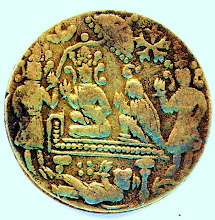Most of the traditional homes of the Hindus have coin - like relics in their puja rooms. Generally they are handed over from one generation to another. These coins made of silver or copper are worshipped by applying sandal paste, turmeric, kumkuma and flowers.
Over the years, encrustations are formed on both sides of these coins making it impossible to recognise the symbols and portrayals on them. If these coins are cleaned properly, in most cases, they turn out to be what we call Ramatanka or Ramatanki, a religious token with portraits of Sri Rama, Sita and Hanuman.
Indians have been paying homage to Sri Rama for the past thousands of years ever since poet Valmiki wrote the great epic Ramayana. Hundreds of literary men in Sanskrit and other Indian languages have composed poems, dramas, prose works and commentaries based upon the story of Rama.
Thus this interesting story has been told and retold for the past two thousand years in India and abroad. Thus it will remain a perennial source for narrating the story of dharma as long as Sun and Moon last.
Music composers, pravachanakaras and folk artists have been taking the story of Rama to the multitudes of illiterate people. Temple builders, sculptors and painters have built hundreds of temples and sculpted images and painted pictures of Sri Rama.
The enchanting story of Sri Rama crossed the Indian Oceans and influenced the daily life and culture of the population in Java, Ceylon, Thailand, Cambodia, Bali, Borneo and other countries. Even today the coronation name of King of Thailand is Sri Rama.
The kings of ancient India did not lag behind in paying homage to Sri Rama. In addition to other mediums, they selected coinage as a medium to express their respect to Sri Rama. Such coins, which contain Sri Rama on one side, are generally referred to as Ramatanka or Rama tanki.
Such coins have been minted in various metals such as gold, silver, brass, bronze and copper. In course of time gold coins became rare yielding place to silver and copper and at most traditional homes silver Ramatankas were worshipped.
Though historians suspect that Ramatanka coins might have been issued from very ancient times, the earliest Ramatanka gold coin so far discovered belongs to twelfth century issued by the Chauhan king of Ajmer Vigraharaja who ruled from 1153 AD. These gold coins on one side have the standing figure of Sri Rama and the writing Sri Rama in Nagari script.
Thakkura Pheru who was a mint - master of Allauddin Khilji wrote a book on coinage titled Dravya Pariksha. This author describes gold Ramatankas and calls them Sita - Rami, which obviously contained the portraits of both Sita and Rama. He further informs that gold Ramatankas of fineness of over 83 per cent and which weigh at least nine grams alone are fit to be kept at home as they are auspicious.
The Hoysala kings who ruled from Dwarasamudra (Halebid) also issued some Ramatankas. The kings of Vijayanagara were great champions of Hindu culture and almost all Hindu Gods were portrayed on their gold, silver and copper coins. King Tirumalaraya of Vijayanagara minted gold coins called Varahas. These coins contain on the obverse side Sri Rama and Sita seated, Lakshmana standing behind in an attitude of devotion and holding a bow on his right shoulder.
Akbar was one of the liberal kings of the Mughal dynasty. Attracted and fascinated by the story of Ramayana, Akbar minted gold coins of Ramatanka type. These gold coins became popular as Rama - Sita type coins.
The obverse side of these coins contain standing Sri Rama with a bow on the right shoulder with Sita to the right and the Nagari writing Rama - Sita. In spite of the Muslim rule, Sri Rama emerged as the God par excellence along with Sita and Hanuman. Many temples came to be built for this God while large number of Sri Rama – Sita - Hanuman sculptures began adorning the temples.
The cult of Hanuman also became prominent, and he came to be represented independently on Vijayanagara coins.
This development gave rise to temples minting Sri Rama – Sita - Hanuman coins in silver not as legal tender but as temple tokens for distribution to devotees on special occasions. This also standardized the Ramatankas, which began to portray standing Sri Rama with Sita, Lakshmana and Hanuman sitting in an attitude of devotion of Sri Rama Pattabhisheka or coronation scene.
These Ramatanka temple tokens inspired other temples to mint coins with Shiva, Vishnu, Durga, Krishna, Narasimha, Sharada etc. Now all the temples worth the name issue temple tokens in imitation of Ramatankas. The prolific and popular Deepavali medals or tokens are quite popular in North India.
Inspired by Ramatanka tradition, middle class traditional families get these coins made in silver with Sri Rama - Sita one side and the other side containing their own name and distributed them on occasions like sixtieth birthday to friends and relatives.
Thus people wait for pretexts to pay homage and respect to Sri Rama, who is universally regarded as Maryada Purushothama. These tokens carry forward the ideas and ideals for which Sri Rama, Sita, Lakshmana and Hanuman stood and worked in the days of yore.




